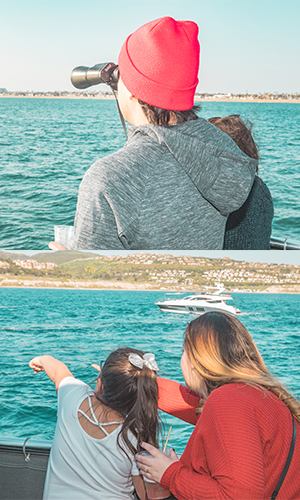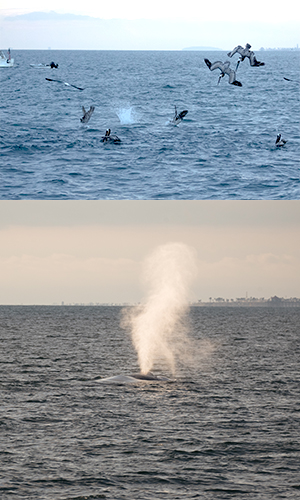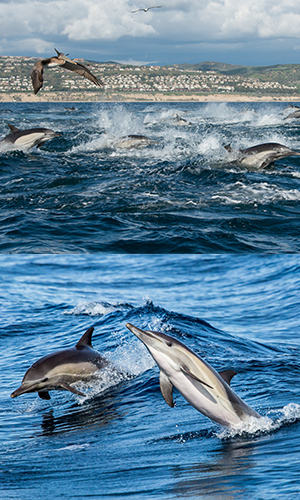How to spot whales and dolphin

Southern California whale watching trips are a fun and convenient way for people to enjoy the ocean and search for wild animals in their natural habitat. Here are some helpful tips and techniques to help you spot whales and dolphin like a professional.
Spotting whales is all done by eyesight. There are no underwater sonars or equipment for actively scanning an area for whales underwater. Sonars work by sending out pulses of sound. Sonar sounds are so strong that it may also cause injury to the animals. Using this type of equipment is not useful for whale watching. There are still lots of tips, tricks, and helpful accessories that our experienced captains and crew use to locate an abundance of marine life.
Helpful tools for spotting whales and dolphin
Here are a few items that are extremely helpful when looking for whales and dolphin.
Sunglasses – Sunglasses are a whale watchers’ best friend, especially in sunny California. Sunglasses not only protect eyes from harmful rays but also keep you comfortable when scanning the sea. The light reflecting off the water can pose a challenge as well so it is recommended to have polarized sunglasses that cut through the troublesome glare.
Binoculars – Binoculars are a great way to enhance your vision and see from great distances. They are more useful on calmer days. Thankfully our local seas in Orange County are typically quite calm! The strength and size of a pair of binoculars is represented by a pair of numbers. An example would be 7×50 or 8×40. The first number is the strength of magnification and the second number is the width of the lens. A wider lens will give you some extra peripheral vision while looking through the lens, which can be crucial when looking for fast moving animals.
Persistence – Persistence is key when looking for whales and dolphin. The ocean is very large and it may take some time to find whales and dolphin. We find these animals swimming free in their natural habitat. We do not have a designated area, enclosure, or tank that they are found in. Spending time looking is the only way. The more time you spend looking the better your chances are. Along with your sunglasses and binoculars we recommend protecting yourself with a hat and sunscreen while spending time in the sun looking for whales and dolphin.


Technique for spotting whales and dolphin
The best technique for spotting whales and dolphin is to scan the horizon line. This should be done without binoculars. By scanning that far your eyes will pick up on anything that pops up or moves between the horizon and the boat. Looking at points below the horizon line excludes a large area from your field of vision.
The whales and dolphin are usually on the move searching for food and keeping an eye out for predators. As a result, they are constantly in motion. If you happen to spot an object at sea floating in place very still at the surface the chances of it being wildlife are much lower. Look for objects in the water that are moving and spending just a small portion of time at the surface between dives. This is where your binoculars will come in handy. Once you spot something use the binoculars to confirm what you are looking at.
While scanning the horizon line you should also periodically scan the sky. It sounds funny since whales and dolphin can’t fly, but our feathered friends do. Birds are an important indicator because marine birds eat the same prey that our local dolphins and whales enjoy. The type of bird can even help indicate the type of prey being eaten. Prey can include small fish such as anchovies, squid, or even krill. If you see a large amount of birds feeding on the oceans surface it’s probably safe to say that underwater animals are also feeding below the surface.
How to spot Whales
The majority of whales spotted in Orange County waters are first spotted via eyesight. Whales are mammals and must breathe air but spend the majority of their life submerged under the surface of the sea. That brief moment when they come up for a breath of air is their primary reason for coming to the surface. The spout that comes with every breath is the most distinctive thing to look for when seeking out larger whales.
The size and shape of a whale’s spout will be determined by the species. We spot five different species of larger whale in Southern California on a regular basis each year. Blue Whales have very tall thick spouts up to 30 feet high, Fin Whales have a tall thin spout over 20 feet high, Humpback Whales have short bushy spouts 15 to 20 feet high, and Gray Whales have a distinct heart shaped spout similar in size to the Humpback Whale. Minke Whales do not give off much of a spout at all and their spout can only be spotted in favorable conditions.
Another less common way to spot whales in Orange County is by surface action. On most surface intervals the larger whales will show no more than 15% of their body at a time, showing mostly the top of their head and back when taking a breath. On special occasions whale watchers are lucky and get to witness surface activity such as showing their flukes, breaching, chin slapping, and lunge feeding and more of the body is visible. When the whale does these activities, it is very easy to spot on the surface of the water.


How to spot Dolphin
Dolphins come up for air but do not spout as large as the whales. In Southern California we spot five different species at least once each year. Bottlenose Dolphin and Common Dolphin are seen frequently, Pacific White Sided Dolphin are seasonal. We also get rare sightings of Orca and Risso’s Dolphin. The best way to spot these animals are the splashes they make at the surface when traveling . The splashes are distinct and almost look like grease frying or popcorn popping on the surface of the sea. You might even see the animals jumping out of the water entirely when they are at play. On windy or choppy days, it can be tricky to differentiate the dolphins from waves and whitecaps.
Dolphins travel in groups called pods and are always on the move, so look for clusters of splashes that appear to be traveling in one direction. Dolphins also jump out of the water and once in close visual range it is easy to see the whole body of the animal as they swim by. The amount of time they spend underwater will be influenced by the size of the animal (bigger dolphins can dive longer) and also the activity they are doing (catching fish requires a longer dive than simple traveling).
Practice your spotting skills
There’s no better way to hone a skill than to practice, and our 2 hour whale watching adventures are a fun and affordable way to get out on the water. You can also get some helpful coaching from our captains and crew if you want! The variety of animals spotted in Newport Beach throughout the year means lots of opportunities to see several different species and any time of year is bountiful. Why not book today and reserve a trip that fits your schedule? We look forward to spotting you on our next whale watching adventure!
